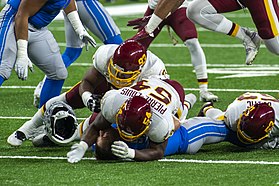
Back Sac (futbol americà) Catalan Sack (American Football) German Quarterback sack Spanish Pelinrakentajan säkitys Finnish Sack French סאק HE Sack (football americano) Italian QBサック Japanese 색 (미식축구) Korean Quarterback sack Polish
In gridiron football, a sack occurs when the quarterback (or another offensive player acting as a passer) is tackled behind the line of scrimmage before throwing a forward pass, when the quarterback is tackled behind the line of scrimmage in the "pocket" and without clear intent, or when a passer runs out of bounds behind the line of scrimmage due to defensive pressure.[1] This often occurs if the opposing team's defensive line, linebackers or defensive backs are able to apply pass pressure (also called a pass rush) to quickly get past blocking players of the offensive team (the quarterback's protection), or if the quarterback is unable to find a back to hand the ball off to or an available eligible receiver (including wide receivers, running backs and tight ends) to catch the ball, allowing the defense a longer opportunity to tackle the quarterback.
Performing a sack is advantageous for the defending team as the offense loses a down, and the line of scrimmage retreats several yards.[2] Even better for the defense is a sack causing the quarterback to fumble the ball at or behind the line of scrimmage; this is also known as a strip sack and can result in a turnover if the defense manages to obtain the ball. A quarterback who is pressured but avoids a sack can still be adversely affected by being forced to hurry.
The quarterback must pass the statistical line of scrimmage to avoid the sack. If a passer is sacked in his own end zone, the result is a safety and the defending team is awarded two points. If the football is fumbled and recovered either inside the end zone by the defense, or outside the end zone and is returned to the end zone this results in a touchdown for the defense.
- ^ "2011 Football Statisticians Manual, p. 17" (PDF). NCAA. Retrieved October 15, 2017.
- ^ Cite error: The named reference
:0was invoked but never defined (see the help page).


